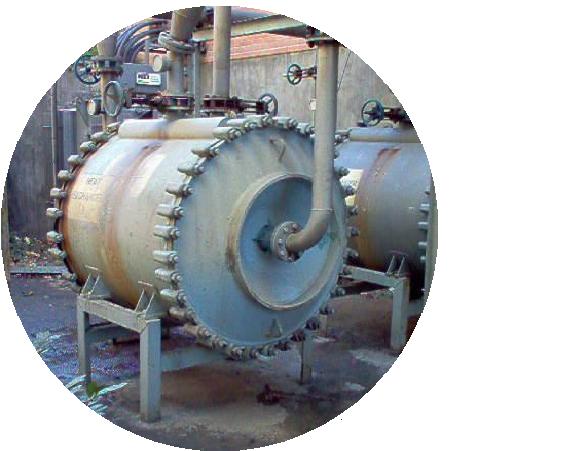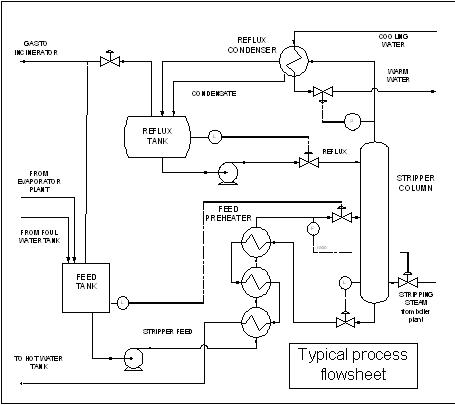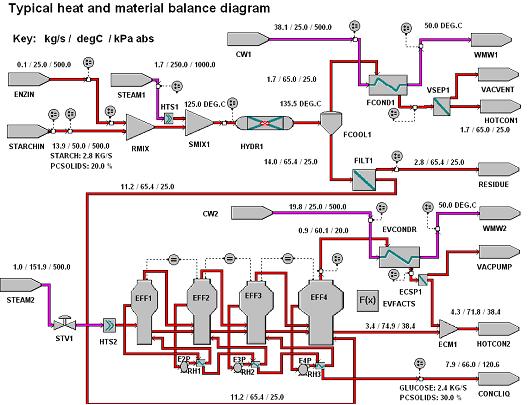
(C) 2006
Harry R Cripps
Process heat recovery
It doesn’t make sense to waste more heat than necessary, yet this is exactly what happens on many process plants. Waste heat is energy which ends up in the environment rather than the product. Some process plants have a considerable number of waste heat flows, eg:- Boiler plant stacks
- Cooling towers
- Dryer exhausts
- Warm overflows and other effluents
- Flash steam from hotwells and condensate tanks
Reducing waste heat
Broadly speaking there are three main aspects of waste heat reduction.- Operate the process on a right first time basis
- it is very wasteful to make off-specification product or to process the same material more than once, especially for energy intensive operations such as drying
- Minimise heat demand of the underlying process
- Optimise the process, for example mechanical dewatering usually requires less energy than evaporative drying so it can pay to dewater as much as possible upstream of dryers
- Maximise the efficiency of thermal utility systems, eg optimise burners, boilers, steam systems etc.
- More fundamentally and longer term, develop less energy intensive ways of making the product and/or less energy intensive products to meet the same customer needs.
- Heat recovery
- reuse waste heat instead of steam or fuel to carry out other heating duties
A focus on heat recovery
In an age of increasing fuel prices and growing concern about the environment, process industries can no longer afford not to optimise heat recovery on their sites.
Key heat recovery questions for all process plants
- How much (more) heat recovery is possible?
- What are the best heat sources and sinks to use?
- What types of heat exchangers are most appropriate?
- Will the heat recovery make the process harder to control?
- Is a heat pump likely to be worthwhile?
- How will heat recovery affect the site CHP system?
- How much will it cost?
- Local or general heat recovery?
For any more complicated or uncertain situations here are some tips:
Heat recovery tips
Heat recovery is based on the principle that heat flows from a higher temperature to a lower temperature in a heat exchanger. Therefore the key to effective heat recovery is understanding both the magnitude and the temperature of (all significant) waste heat streams and heating demands on the site.
Step 1 Identify significant heat sources and sinks on the plant on the site.
To understand the energy flows in a process requires appropriate flowsheets:- formal process and instrumentation diagrams (P&IDs) are usually too detailed
- tourist flowsheets/pictograms are seldom rigorous nor detailed enough
- control room VDU screens are optimised for plant operation rather than energy analysis.

Step 2 Quantify the heat sources and sinks
It is necessary to determine the magnitude (energy flow) and temperature of the streams and to understand when they occur (continuous or batch operation, duration, etc).The most reliable way to quantify flows is usually by making heat and material balances. These are consistent snapshots of the process under the relevant operating conditions.
The balances need to be consistent to the extent that material and energy flows and temperatures at different parts of the plant all tie up with each other. This is not the same as trying to measure all the major flows directly. Firstly, if additional instrumentation is required, measuring flows in particular can be unrealistically expensive. Secondly, quite often there isn’t a practicable way to measure some of the flowrates reliably.
In many cases only a small percentage of process streams ultimately turn out to be directly relevant to heat recovery but a fairly comprehensive H&M balance is often the only certain way to get reliable figures for the flows which do turn out to be important.
In simple cases adequate H&M balances can be made by hand calculation. Beyond that, spreadsheet balances or specialist flowsheet simulation software may be the best way forward. Different calculation platforms have advantages and disadvantages depending on the context.
Using a robust calculation model it is possible to minimise the number of extra measurements necessary to get reliable flow and temperature figures for all relevant streams.

Several industries have been reluctant to appreciate the benefits of heat and material balances. Some may ask if there any point in quantifying a large number of flowrates and temperatures which are not needed to operate the plant. As far as heat recovery is concerned, having a larger number of heating and cooling duties could make it more difficult to decide which ones to use - a reasonable objection before the advent of Pinch analysis.
Experience has shown that it is often most efficient to carry out a preliminary analysis using approximate but wherever possible reliably representative data and to revisit this when preliminary findings have indicate which numerical values are most important. A second pass can then be undertaken either to measure or calculate some parts of the balance more accurately.
(For help with heat and material balances see author's web site)
Step 3 Calculate the scope for heat recovery
In simple cases, once the heat sources and sinks have been quantified, it is relatively simple to calculate how much heat can be recovered. It is necessary to make reasonable assumptions about the type of heat exchangers needed and economical approach temperature. These can be reviewed and optimised at a later stage (see principles of heat exchangers and approach temperature v capital cost).When there are several or many heat sinks and sources, a systematic analysis is needed to determine how much heat can be recovered and which source and sink streams need to be exchanged in order to reach the savings target.
The best way to do this is usually by Pinch Analysis. Pinch is a key part of the wider discipline of process integration. By taking account simultaneously of flowrates and temperatures for all heating and cooling duties on the plant, it is a powerful and systematic tool for assessing heating and cooling opportunities. This was a major breakthrough when it was first widely used in the 1980s. It is best carried out using dedicated software.
Most process plants have a thermal Pinch point - a temperature above which there is an overall shortage of heat and below which there is a surplus. Armed with this information and some procedures which logically follow from, it is possible to calculate the maximum amount of recoverable heat and thus the minimum amount of paid-for steam or fuel required by the process.
The analysis identifies which heat sources must be matched with which demands in order to maximise savings. Also, and potentially almost as useful, it shows which existing heat transfer duties are cross-pinch and thereby restrict the amount of savings that can ultimately be achieved.
Hence it is possible to design heat recovery projects confident that they will not conflict with other potentially better (future projects) and to develop a strategy for ongoing energy savings.
There are other benefits from Pinch analysis beyond the scope of this paper. In particular, these include optimum configuration of thermal utilities and CHP systems.
(For further information about Pinch Analysis see Elements of Pinch Analysis)
Step 4 Conceptual design and optimisation of projects
Once the scope for heat recovery is known in principle and potential heat recovery configurations have been outlined, real projects need to be designed. In many ways, a heat recovery project is no different from any other process project but there are some issues which need to be resolved:- Optimising the amount of heat recovered. On most projects with heat recovery exchangers, the more you pay for the exchanger (additional heat transfer surface) the more heat you can recover but the more investment is required. See Selection of heat exchanger specification
- Optimising the heat recovery flowsheet configuration and control system. Because heat recovery interlinks different parts of a process (or even a whole site) it is particularly important that the system is correctly configured and controlled. See Heat recovery flowsheet and control concept design
Heat pumps and heat recovery
The idea of a heat pump is very appealing. By doing some work (input of a relatively small amount of high grade energy) it is sometimes possible to increase the temperature of a waste heat stream sufficiently to be able to use the waste heat for a heating duty at a higher temperature.In some cases, heat pumps can achieve very worthwhile savings but it is counter-productive to use work (expensive energy) for this purpose if there is an alternative of direct heat transfer to reuse the waste stream or satisfy the heating duty. If there are several waste streams and/or heating duties available, it is seldom obvious which alternatives are possible until a Pinch analysis has been carried out.
NB Refrigeration systems are almost always based on a heat pump system but the primary objective is cooling rather than useful heat recovery. If your plant has refrigeration dutie(s), you should consider whether (more) heat rejected from the refrigeration condensers could be usefully recovered to save fuel. Sometimes this is straightforward. In other situations it may be possible to modify the refrigeration system slightly in order to reject the heat at a temperature which facilitates useful heat recovery. Again, Pinch analysis provides a systematic way to understand the opportunities.
NB The author has identified a number of opportunities for viable heat pumps to recover heat on process plants. However, with the exception of refrigeration systems, the number of worthwhile opportunities to recover energy with heat pumps has been much smaller than for those where direct heat transfer can achieve almost as much saving at a smaller cost.
Combined heat and power (CHP) and heat recovery
Combined heat and power is one of the best ways to improve overall energy efficiency on process plants. Depending on which way one looks at it, using waste heat from a power generation system (typically a turbine or a reciprocating engine) to heat the process amounts to either:- Heating the process, for a minimal net energy cost or
- Generating (electrical) power at a much higher efficiency than is otherwise possible.
(For more information about process integration and CHP see Process integration for optimum energy efficiency)
Is localised or site-wide heat recovery best?
On many sites, it is technically feasible to recover some heat locally on or around a particular process operation or a larger amount of heat by recovering it between different units or locations over the whole site. This can make it very difficult to decide which projects to implement. In these circumstances, it is recommended to carry out a Pinch analysis of each of the site operations and then combine the data into a site-wide analysis. This provides a clear and systematic perspective on the opportunities.(For more information about localised vs. site-wide heat recovery see Process integration for optimum energy efficiency)
If you found this page in isolation through a search engine, you might want to check out other free advice from the Energy Management Register